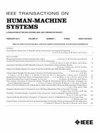在柔性传感器手套中利用格拉米安角场和卷积神经网络实现人机交互
IF 3.5
3区 计算机科学
Q2 COMPUTER SCIENCE, ARTIFICIAL INTELLIGENCE
引用次数: 0
摘要
目前使用人机接口的传感器系统开发手势识别系统仍具有挑战性。本研究利用 16-DoF 手套传感器和卷积神经网络开发了手势识别系统。挠性传感器附着在手套上人体手部的 16 个枢轴关节上,以便在握住物体时测量每个关节的挠性。本研究开发了 16-DoF 点传感器采集电路和可调缓冲电路,可与 Arduino Nano 微控制器配合使用,记录每个传感器的信号。本文研究了将柔性传感器信号的时间序列数据转换成二维彩色图像,将信号串联成一个具有格拉米安角场的大图像,然后通过深度卷积神经网络(DCNN)进行识别。提出的 16-DoF 手套传感器使用 8 种 DCNN 识别模型进行了三次实验。这些实验分别针对 20 个手势识别、12 个手势识别和根据形状操纵物体进行。实验结果表明,Resnet 101 在手部抓握实验中的最佳性能为 99.49%,Alexnet 在手势实验中的最佳性能为 100%,InceptionNet V3 在物体属性实验中的最佳性能为 99.77%。本文章由计算机程序翻译,如有差异,请以英文原文为准。
Utilizing Gramian Angular Fields and Convolution Neural Networks in Flex Sensors Glove for Human–Computer Interaction
The current sensor systems using the human–computer interface to develop a hand gesture recognition system remain challenging. This research presents the development of hand gesture recognition with 16-DoF glove sensors combined with a convolution neural network. The flex sensors are attached to 16 pivot joints of the human hand on the glove so that each knuckle flex can be measured while holding the object. The 16-DoF point sensors collecting circuit and adjustable buffer circuit were developed in this research to work with the Arduino Nano microcontroller to record each sensor's signal. This article investigates the time-series data of the flex sensor signal into 2-D colored images, concatenating the signals into one bigger image with a Gramian angular field and then recognition through a deep convolutional neural network (DCNN). The 16-DoF glove sensors were proposed for testing with three experiments using 8 models of DCNN recognition. These were conducted on 20 hand gesture recognition, 12 hand sign recognition, and object manipulation according to shape. The experimental results indicated that the best performance for the hand grasp experiment is 99.49% with Resnet 101, the hand sign experiment is 100% with Alexnet, and the object attribute experiment is 99.77% with InceptionNet V3.
求助全文
通过发布文献求助,成功后即可免费获取论文全文。
去求助
来源期刊

IEEE Transactions on Human-Machine Systems
COMPUTER SCIENCE, ARTIFICIAL INTELLIGENCE-COMPUTER SCIENCE, CYBERNETICS
CiteScore
7.10
自引率
11.10%
发文量
136
期刊介绍:
The scope of the IEEE Transactions on Human-Machine Systems includes the fields of human machine systems. It covers human systems and human organizational interactions including cognitive ergonomics, system test and evaluation, and human information processing concerns in systems and organizations.
 求助内容:
求助内容: 应助结果提醒方式:
应助结果提醒方式:


